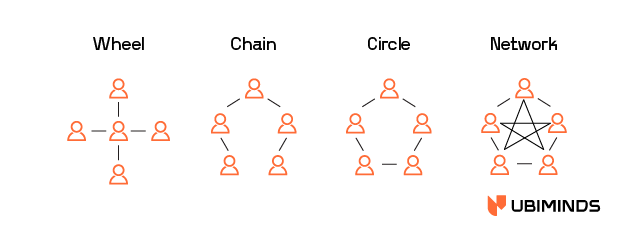Why bother talking about soft skills and communication patterns? Because let’s face it: every action and decision ripples through budget and profit margins. Clear communication can be a shortcut to a healthier bottom line by systematically avoiding miscommunication and misunderstandings — especially in remote teams. Stick around, and we’ll show you why fixing those Slack channels, and email threads can be the best financial move your software company can make.
Content
Ready to hack your way to more dollars and fewer frowns? Let’s dive into the nitty-gritty of communication patterns. Keep scrolling to amp up your team’s game and skyrocket your software business’s efficiency.
Decoding Communication Patterns in Software Teams
What exactly are they, and why are they crucial? In Jacqui Read’s insightful book, Communication Patterns: A Guide for Developers and Architects the focus is on unraveling the intricate threads of communication within software teams. Let us borrow from him.
Similar to how building blocks come together to create a structure, communication patterns form the basis for effective team dynamics, problem-solving, and decision-making. The author classifies them under three categories:
Jacqui’s 3 Types of Communication
#1 Interaction Patterns | These govern how team members engage with one another. Clear interaction patterns streamline communication, fostering collaboration and reducing misunderstandings. Example: Daily Stand-up Meetings Purpose: Facilitate quick updates and synchronize team members. Impact: Enhances communication, ensures everyone is on the same page, and fosters a sense of collaboration. |
#2 Problem-solving Patterns | These guide the team in addressing challenges. Whether it's debugging code or overcoming project hurdles, established problem-solving patterns enhance efficiency and coherence in tackling issues. Example: Root Cause Analysis Purpose: Identify the underlying cause of issues or bugs. Impact: Encourages a systematic approach to problem-solving, leading to more effective and lasting solutions. |
#3 Decision-making Patterns | Decisions are integral to any software project. Different patterns dictate how decisions are reached, ensuring a structured and effective decision-making process that aligns with team objectives. Example: Consensus-Based Decision Making Purpose: Involve the entire team in decision-making. Impact: Ensures diverse perspectives are considered, promoting a collective sense of ownership and commitment. |
In sum, understanding these patterns becomes a lens through which teams can enhance their communication dynamics and strengthen communication. And why is that crucial? As we’ll explore later in this article, poor dynamics can lead to increased expenses, unmet requirements, and an architectural outcome different from the intended vision.
How People Communicate in Software Companies
Jacqui also introduced different chains of communication within software businesses and teams.

The Financial Perspective: How Miscommunication and Misunderstanding Costs Your Business
While miscommunication addresses the effectiveness of the communication process in remote teams, misunderstanding delves into the accuracy of the interpretation. Both factors contribute to a range of challenges within software teams, impacting productivity, quality, and ultimately, the financial outcomes of the business.
| Miscommunication | Misunderstanding | |
|---|---|---|
| Definition | Miscommunication occurs when information is not effectively conveyed or understood as intended. | Misunderstanding involves the misinterpretation or incorrect comprehension of communicated information. |
| Examples | Unclear messages Inadequate context Breakdown in the transmission of information | It occurs when individuals perceive information differently than intended, leading to confusion and potential errors. |
| Impact | This may lead to discrepancies in project requirements, divergent interpretations of tasks, and a lack of alignment on objectives. | Misunderstanding can result in the implementation of incorrect features, suboptimal code, or the delivery of solutions that do not meet client expectations. |
So how can we ensure neither will happen? Even more so, what to do when dealing with different time zones and without face-to-face interactions?
In the following sections, we will explore specific instances of miscommunication and misunderstanding within software teams, shedding light on their financial implications and providing insights on how to mitigate these risks.
10 Ways Solid Communication Impacts the Bottom Line
1: Clear Deadline Communication
In SaaS development, precise deadlines are crucial. Clear communication ensures synchronous efforts, reducing the risk of misunderstandings and facilitating timely project completion — let's say, a product launch.
- Sample Scenario: The Tech Lead communicates a task deadline via email to a distributed team, specifying the time zone. This clarity ensures everyone understands the deadline, preventing delays and enhancing SaaS project efficiency.
- Efficient Practice: Specify time zones when communicating deadlines to align the team, using project management tools to track and manage deadlines effectively.
- Impact on the Bottom Line: Timely project completion can lead to improved Time to Market (TTM), a crucial metric in the SaaS industry.
2: Preparedness for Virtual Presentation Glitches
Product presentations, often conducted through video conferencing, are common. Having backup plans ensures seamless communication, preserving the professional image and stakeholder confidence in your product and company.
- Sample Scenario: During a vital virtual presentation, the Product Owner faces technical issues but shares a backup plan through a designated chat channel. This proactive approach minimizes confusion, keeping the SaaS audience engaged.
- Efficient Practice: Share presentation materials in advance, establish communication channels for troubleshooting, and conduct tech rehearsals to preemptively address glitches.
- Impact on the Bottom Line: Professional and glitch-free presentations can positively influence Customer Satisfaction Scores (CSAT) and stakeholder confidence.
3: Comprehensive Handover Procedures
In SaaS, client interactions are vital. A comprehensive handover guarantees uninterrupted client communication, maintaining service quality in SaaS development.
- Sample Scenario: A Tier II Support Team member, before taking a week off, utilizes a standardized handover checklist. This ensures all critical tasks and meetings, including a client meeting, are communicated, preventing disruptions.
- Efficient Practice: Implement standardized handover checklists and use collaboration platforms to document and share critical information seamlessly.
- Impact on the Bottom Line: Uninterrupted client communication contributes to Customer Retention Rates, a key financial metric for SaaS companies.
4: Constructive Written Feedback
Lean development is all about continuous improvement — after all, testing and constructive feedback is key for innovation. Positive communication motivates teams, enhancing productivity and learning.
- Sample Scenario: A Mobile Lead sends constructive feedback via email (which can be consulted several times in the future), emphasizing positive language. This fosters a positive work environment, reducing anxiety and promoting open communication within SaaS teams.
- Efficient Practice: Encourage seeking clarification, promote positive language, and use collaborative tools for real-time feedback and discussions.
- Impact on the Bottom Line: Continuous improvement through constructive feedback can positively influence the Rate of Innovation, a vital DORA metric. It also helps team members to grow and improve, delivering more value over time.
5: Engaging Virtual Team Building
Team collaboration is crucial for product development. Engaged teams contribute creatively, positively impacting product development lifecycle. In teams where members are remotely distributed, bonding and collaboration need extra attention.
- Sample Scenario: The Head of Engineering provides detailed instructions for a virtual team-building activity, ensuring remote team members feel included. This fosters better engagement and reduces frustration within SaaS teams.
- Efficient Practice: Clearly communicate expectations beforehand, provide detailed instructions, and use collaboration platforms to enhance team engagement.
- Impact on the Bottom Line: Improved Team Engagement correlates with increased Productivity and higher-quality SaaS solutions.
6: Organized File Management and Documentation
Version control is crucial for collaborative development, and documentation can make things much easier for future teams dealing with legacy code. Efficient access speeds up the SaaS development process.
- Sample Scenario: A remote team member uploads a project file to a well-organized shared drive, following a structured system. This minimizes file-related delays and frustrations for the entire SaaS team.
- Efficient Practice: Establish and communicate a structured file organization system, utilizing version control tools for seamless collaboration.
- Impact on the Bottom Line: Efficient File Management can positively impact Project Throughput, speeding up the SaaS development process.
7: Recorded Virtual Meeting Instructions
Accurate understanding of project details is critical. Recorded meetings serve as valuable references, reducing the risk of misinterpretation. Repeatedly watching user interviews can bring new angles, for example.
- Sample Scenario: The Tech Lead records important virtual meetings, allowing remote team members to review and clarify missed instructions. This ensures accurate SaaS project execution.
- Efficient Practice: Record important virtual meetings, provide access to recordings, and encourage SaaS team members to review and seek clarification.
- Impact on the Bottom Line: Accurate understanding of project details can positively influence Deployment Frequency, a critical DORA metric.
8: Inclusive Team Brainstorming
Diverse perspectives lead to creative solutions. Inclusive meetings promote idea generation and problem-solving in software development.
- Sample Scenario: During a distributed team brainstorming session, ground rules are set to ensure equal participation. Remote team members actively contribute, fostering a collaborative and inclusive environment.
- Efficient Practice: Set ground rules for inclusive participation, encourage remote contributions, and acknowledge diverse ideas during discussions.
- Impact on the Bottom Line: Inclusive Team Collaboration can positively influence the Number of Deployments, contributing to faster innovation cycles.
9: Consistent Communication Tools Adoption
Streamlined communication is crucial for project coherence. Consistent tool adoption reduces errors and collaboration.
- Sample Scenario: The team adopts consistent communication tools and protocols, preventing missed messages and fragmented communication. This ensures efficient information exchange within SaaS teams.
- Efficient Practice: Establish and communicate communication protocol guidelines, promoting consistent tool adoption for effective collaboration.
- Impact on the Bottom Line: Consistent Communication contributes to a reduction in Change Failure Rate, improving overall SaaS service reliability.
10: Clarity in Written Communication
When working asynchronously, clear communication is even more critical for project success. Avoiding misunderstandings accelerates project timelines.
- Sample Scenario: Team members promote clear and unambiguous language in written communication, avoiding misinterpretations. This practice fosters a positive SaaS team culture.
- Efficient Practice: Emphasize clear and unambiguous language, provide context when necessary, and use collaboration tools for effective written communication.
- Impact on the Bottom Line: Clear Written Communication through pre-agreed channels positively influences Mean Time to Recover (MTTR), a critical metric for SaaS incident response efficiency.
By proactively addressing communication challenges, you foster a collaborative and efficient work environment. At the end of the day, implementing efficient practices tailored to the SaaS context contributes to overall business success.
Increase Your Profitability with Ubiminds
Ready to transform your team's communication into a profit rocket with Ubiminds. Build exceptional distributed teams in Latin America by unlocking A-list talent at different pay grades, ensuring excellence in product development, and fostering continuous improvement and efficiency.
a. Unlock A-List Talent at New Pay Grade Variations
Ubiminds specializes in finding top-notch software talent across different pay grades in Latin America. Whether you're looking for seasoned experts or rising stars, we connect you with professionals who not only excel in their roles, but also align with your budgetary considerations.
b. Ensure Excellence in Product Development
We go beyond recruitment – we ensure that the professionals we connect you with are highly qualified and equipped to build products that users love. With a focus on technical expertise and a passion for innovation, our talent contributes to the success of your projects.
c. Foster Continuous Improvement and Efficiency
Ubiminds believes in the power of ongoing support. We don't just stop at recruitment; we continuously follow up with our talent while on the job. Additionally, we invest in their soft skill development to enhance collaboration and communication within your distributed team. This holistic approach ensures that your team operates at peak efficiency.
Ready to experience the Ubiminds difference? Fill out the form to learn more and take the first step towards building a profitable distributed team with exceptional talent.

International Marketing Leader, specialized in tech. Proud to have built marketing and business generation structures for some of the fastest-growing SaaS companies on both sides of the Atlantic (UK, DACH, Iberia, LatAm, and NorthAm). Big fan of motherhood, world music, marketing, and backpacking. A little bit nerdy too!





